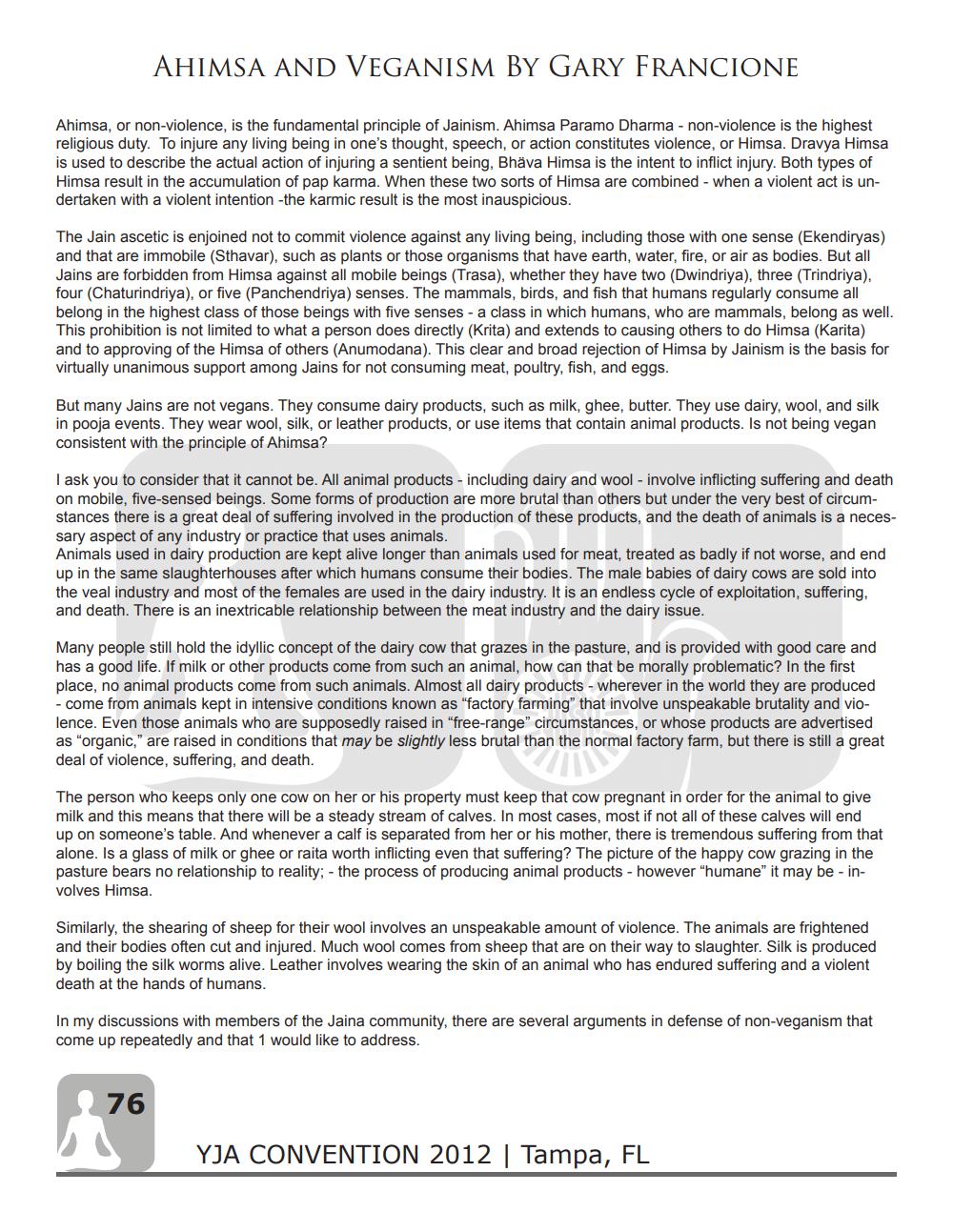________________
AHIMSA AND VEGANISM BY GARY FRANCIONE
Ahimsa, or non-violence, is the fundamental principle of Jainism. Ahimsa Paramo Dharma-non-violence is the highest religious duty. To injure any living being in one's thought, speech, or action constitutes violence, or Himsa. Dravya Himsa is used to describe the actual action of injuring a sentient being, Bhäva Himsa is the intent to inflict injury. Both types of Himsa result in the accumulation of pap karma. When these two sorts of Himsa are combined - when a violent act is undertaken with a violent intention - the karmic result is the most inauspicious.
The Jain ascetic is enjoined not to commit violence against any living being, including those with one sense (Ekendiryas) and that are immobile (Sthavar), such as plants or those organisms that have earth, water, fire, or air as bodies. But all Jains are forbidden from Himsa against all mobile beings (Trasa), whether they have two (Dwindriya), three (Trindriya). four (Chaturindriya), or five (Panchendriya) senses. The mammals, birds, and fish that humans regularly consume all belong in the highest class of those beings with five senses - a class in which humans, who are mammals, belong as well. This prohibition is not limited to what a person does directly (Krita) and extends to causing others to do Himsa (Karita) and to approving of the Himsa of others (Anumodana). This clear and broad rejection of Himsa by Jainism is the basis for virtually unanimous support among Jains for not consuming meat, poultry, fish, and eggs.
But many Jains are not vegans. They consume dairy products, such as milk, ghee, butter. They use dairy, wool, and silk in pooja events. They wear wool, silk, or leather products, or use items that contain animal products. Is not being vegan consistent with the principle of Ahimsa?
I ask you to consider that it cannot be. All animal products - including dairy and wool - involve inflicting suffering and death on mobile, five-sensed beings. Some forms of production are more brutal than others but under the very best of circumstances there is a great deal of suffering involved in the production of these products, and the death of animals is a necessary aspect of any industry or practice that uses animals. Animals used in dairy production are kept alive longer than animals used for meat, treated as badly if not worse, and end up in the same slaughterhouses after which humans consume their bodies. The male babies of dairy cows are sold into the veal industry and most of the females are used in the dairy industry. It is an endless cycle of exploitation, suffering, and death. There is an inextricable relationship between the meat industry and the dairy issue.
Many people still hold the idyllic concept of the dairy cow that grazes in the pasture, and is provided with good care and has a good life. If milk or other products come from such an animal, how can that be morally problematic? In the first place, no animal products come from such animals. Almost all dairy products - wherever in the world they are produced - come from animals kept in intensive conditions known as "factory farming" that involve unspeakable brutality and violence. Even those animals who are supposedly raised in "free-range" circumstances, or whose products are advertised as "organic," are raised in conditions that may be slightly less brutal than the normal factory farm, but there is still a great deal of violence, suffering, and death.
The person who keeps only one cow on her or his property must keep that cow pregnant in order for the animal to give milk and this means that there will be a steady stream of calves. In most cases, most if not all of these calves will end up on someone's table. And whenever a calf is separated from her or his mother, there is tremendous suffering from that alone. Is a glass of milk or ghee or raita worth inflicting even that suffering? The picture of the happy cow grazing in the pasture bears no relationship to reality; - the process of producing animal products - however "humane" it may be-involves Himsa.
Similarly, the shearing of sheep for their wool involves an unspeakable amount of violence. The animals are frightened and their bodies often cut and injured. Much wool comes from sheep that are on their way to slaughter. Silk is produced by boiling the silk worms alive. Leather involves wearing the skin of an animal who has endured suffering and a violent death at the hands of humans.
In my discussions with members of the Jaina community, there are several arguments in defense of non-veganism that come up repeatedly and that 1 would like to address.
76
YJA CONVENTION 2012 | Tampa, FL




